Arts
Across cultures; Fused cultures?
A ballet - opera in Sinhala:
by Indeewara Thilakarathne and Ranga Chandrarathne
“The emperor doest not know the love,
The great wall runs through China,
As a meandering serpent,
|
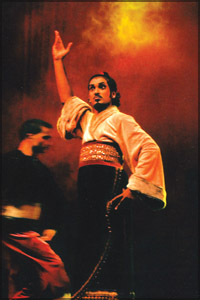
A scene from ballet - opera |
Burying the blood, toil and sigh,
Of thousands of innocents”
These evocative lines sum up the crust of the story which makes the
ballet-opera Patavi which was held recently at the BMICH. Patavi is
woven around true Chinese story in the days when the Great Wall of China
was built. The emperor was cruel and did not care about thousands of men
who had been forced to work on the construction of the Great Wall of
China. Thousands of men died and buried under the wall.
“The Great Wall,
Being built against life,
Burying humanity,
With forced labour”
The construction of the wall was a tragedy as thousands who did not
comply with the royal decree, were summarily executed by soldiers.
Patavi lives in a remote hamlet with her husband. They were just married
and soldiers took her husband to work at the wall. Patavi’s husband died
whilst shouldering a huge boulder. His body was laid on the bank of the
river where the wall was being constructed. Patavi without knowing her
husband’s tragic death puts final touches to a jacket for her lover.
Upon failure to send the jacket through a messenger, Patavi herself
embarked on a long journey in search of her husband, braving harsh
winter.
She reached the wall only to be find her husband’s body lying on the
site while the workers were busy working on the wall paying no respect
to the dead.
Patavi cursed the emperor and Ministers who were executing the work.
Suddenly, weather changed and the wall collapses under a horrendous
thunderstorm. Workers stopped work and the emperor punishes his
Ministers for failing to get the work done from the workers. The story
comes to an end when the emperor visits the site and makes an
unsuccessful bid to win the heart of Patavi. He saw the genuine love in
her eyes. However, courageous Patavi changes her plan for a moment,
agrees to marry the emperor if he offers a decent funeral for her
husband. Accordingly a funeral was performed with State honours.
However, Patavi takes her life in the name of love by jumping into the
river.
Although the story was woven around a Chinese legend, it has been
aptly adapted into Sinhala theatre with indigenous characteristics so
that it would be a part of Sinhala theatre. The storyline has been
altered to give an authentic Sri Lankan flavour. Beneath the storyline
lies the eternal class struggle and triumph of the working class against
the oppression of the ruling class.
|
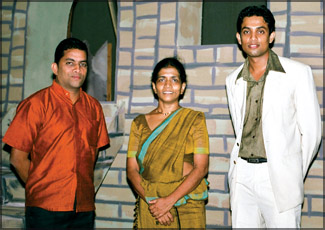
Script writer Gaya Ramya de Alwis, Director Thanuja Priyanthi
Bandula and organiser of the ballet-opera Niranga Wijesuriya |
Thanuja wants to highlight how workers won their rights by collective
bargaining. Even the emperor had to bow down to the people’s power. The
ballet-opera is also a romance which among other things, highlights that
strong bond between lovers cannot be severed even by death. Patavi
sacrificed her life on alter of love. It was love that enabled her to
brave harsh weather and even to defy the mighty emperor.
Costumes and music scores for the ballet-opera was by Thanuja herself
and she has made a genuine effort to create a true Chinese ambiance.
Bright colours like red, blue and yellow typified with Chinese culture
have been heavily used in the set so that it not only look Chinese but
feel Chinese.
Although theoretical aspects of opera music has been used in
composing music scores, Thanuja has employed an array of instruments,
instead of using a keyboard to generate sounds of different instruments
of music, including a double bass, cello, six violins and a flute.
Significant characteristics of the music scores is that Thanuja has
tried to use Chinese traditions of music. She has been influenced by
Chinese authentic dress habits. This can be seen in costume design. For
instance, the outfits of Chinese workers have been used. Chinese style
of ballet has also been employed in the production.Patavi will offer a
meaningful theatre experience for Sri Lankan theatregoers and is poised
to be a remarkable adaptation in the contemporary Sinhala
theatre.Although the production seemed to be just right, it has to be
noted that the movements of members of the troupe were jolted perhaps,
due to the slippery nature of the BMICH stage. Music scores, at times,
failed to completely integrate into the ballet-opera. Sometimes the
music scores generated an abortive effect on the ballet-opera. In fact,
at some points, the music drowned the ballet effect.
Although costumes have been localized, it should be noted here that
they were not as colourful and pleasing to the eyes as the authentic
Chinese costumes are.
Work shop for puppeteers
THIDORA - Theatre Institute for Disability Oriented Research and
Advocacy has embarked on a project to give a helping hand puppeteers.
The project which is launched with the sponsorship of CEPA, intends
to conduct a one-day seminar and a five-day workshop for traditional as
well as amateur puppeteers.
Details of the seminar and workshop can be obtained from Rohana Deva,
Chairman Thidora, No. 1136/B5, Pannipitiya Road, Thalawatugoda. (R.C.)
 ‘Reflections
in Colour’ ‘Reflections
in Colour’
“Reflections in Colour”, an exhibition of paintings by Jayani
Pinnawala will be held from October 3 to 5, at the Lionel Wendt Art
Gallery. (R.C.)
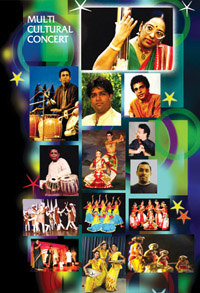 "Harmony
"in Galle "Harmony
"in Galle
"Harmony ", a multicultural concert of music by Aru Sri Art Theatre
in
collaboration with Sleills Development Fund Ltd and Ministry of
Vocational
and Technical Training will be held on September 26 ,2008, at 6.00p.m
at
Town Halle Auditorium in Galle.
Leading performers of all ethnic groups will participate in the
concert
which is focused on the unity in diversity. Contact Sudath Indrajith
( 077-3187291 ) and Gamini Somarathne ( 077-7447530 ) to obtain
invitations.
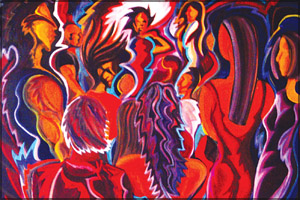
|
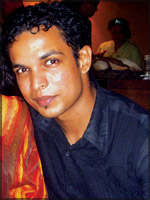
Sanoj de Alwis |
Dreamscape - a world a dream
Dreamscape, an exhibition of paintings by Sanoj de Alwis will be held
on September 20, 21 and 23 at the Lionel Wendt - Harold Peiris Gallery.
Sanoj has used media such as oil on canvas, pastels and charcoal.
Sanoj who graduated from the Swinburne University of Technology, had
completed his work in Australia. He has evolved his own style over the
years. (RC)
|
